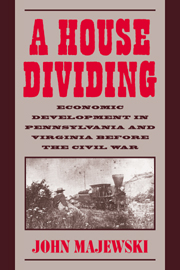Book contents
- Frontmatter
- Contents
- List of Tables
- List of Abbreviations
- Acknowledgments
- Maps
- Introduction: Regional Development in Comparative Perspective
- 1 Developmental Corporations in a Slave-Labor Society
- 2 Developmental Corporations in a Free-Labor Society
- 3 Railroads and Local Development
- 4 The Local Politics of Market Development
- 5 Urban Capital and the Superiority of Pennsylvania's Transportation Network
- 6 Why Antebellum Virginians Never Developed a Big City: Comparative Urban Development in Philadelphia and Eastern Virginia
- Epilogue: Railroad Networks and the Civil War
- Appendix on Sources and Methods
- Bibliography
- Index
2 - Developmental Corporations in a Free-Labor Society
Published online by Cambridge University Press: 07 September 2010
- Frontmatter
- Contents
- List of Tables
- List of Abbreviations
- Acknowledgments
- Maps
- Introduction: Regional Development in Comparative Perspective
- 1 Developmental Corporations in a Slave-Labor Society
- 2 Developmental Corporations in a Free-Labor Society
- 3 Railroads and Local Development
- 4 The Local Politics of Market Development
- 5 Urban Capital and the Superiority of Pennsylvania's Transportation Network
- 6 Why Antebellum Virginians Never Developed a Big City: Comparative Urban Development in Philadelphia and Eastern Virginia
- Epilogue: Railroad Networks and the Civil War
- Appendix on Sources and Methods
- Bibliography
- Index
Summary
The Susquehanna, lying on Cumberland County's eastern border, was clearly a river of major importance. Although shallow and filled with rapids, it was a major thoroughfare in the colonial period, and would later become an important weapon in the trade war between Philadelphia and Baltimore. Yet even with such high stakes, the early efforts to improve the river strongly resembled Jefferson's trusteeship that had improved the Rivanna River in colonial Albemarle. Carlisle merchant Robert Whitehill, Jr., received two circulars in 1795 that asked for contributions to improve the river to Pennsylvania's state line. The circulars outlined the important commercial advantages of improving the river, but its authors also appealed to public spirit as well. “Let all give to what all will be greatly benefited by,” the circular declared. ”We see and feel that our interest is one – Let each consider it as his own.” As was the case with Jefferson's Rivanna River project 30 years earlier, the project's promoters expected prominent gentlemen to contribute. At the bottom of one circular a handwritten note instructed Whitehill to “direct and forward the enclosed Copies to such respectable & influential Characters of your neighborhood as you think most likely to assist with us in opening the River.”
The circular addressed to Whitehill foreshadowed the essential similarities between Cumberland's developmental corporations and those in Albemarle. Many of Cumberland's developmental corporations performed even worse than those of Albemarle, often failing to pay a cent in dividends.
- Type
- Chapter
- Information
- A House DividingEconomic Development in Pennsylvania and Virginia Before the Civil War, pp. 37 - 58Publisher: Cambridge University PressPrint publication year: 2000

